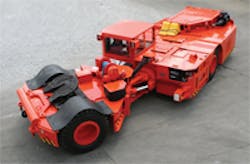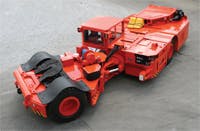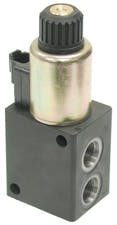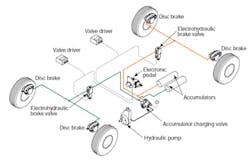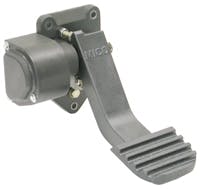Equipment design is a process usually driven by a problem or need that requires a solution. End users who encounter issues on the job may report their experiences to an equipment distributor. The distributor shares the feedback with the OEM, who then begins working on a solution, perhaps with the help of a component manufacturer. Occasionally the problem that starts this chain of communication is a flawed product. But far more often it’s just about finding a more efficient and productive way to get work done.
In mining applications — and underground mining in particular — productivity isn’t only about equipment capabilities, but also about whether a given machine can withstand the extreme conditions to operate effectively in the first place. Of course, reduced productivity isn’t the only consequence of a potential machine breakdown in a mine. Safety is always a concern when machines are used, and safety is the top priority in the underground mine industry. Mining machines must be safe to use, and when components such as brakes are considered, any adverse performance characteristic can produce devastating consequences.
Braking in a mining environment
Equipment originally built for surface mining often finds its way into underground applications eventually. Unfortunately, some machines that do excellent work above ground may quickly succumb to the difficult operating conditions below the surface:
• Unseen bumps or holes can cause jarring impact and shock — enough to seriously damage vehicles or their components.
• Thick sludges can build up like freshly poured cement and impede equipment movement.
• Moisture and airborne contaminants combine to create a corrosive environment that can eat away at exposed and vulnerable parts.
The third point is the primary reason why air brake systems are not conducive to underground mining and are not usually used in these applications. When air brakes were used in the 1960s, mining vehicles used heavy refrigeration dryers and other mechanisms in an inefficient attempt to prevent the moist air of mines from corroding system components.
Straight-apply hydraulic brakes supplanted air systems in the 1970s, and by the 1980s spring-applied, hydraulically released brakes had become the norm. These hydraulic systems provided the opportunity to enclose the brakes and run them in oil, protecting from a mine’s corrosive elements.
Hydraulic brakes have been proven to last longer in rough environments like mining, giving them a stronger long-term ability to meet key Mine Safety and Health Administration (MSHA) standards. One of these is Title 30, Code 57.14101 (a)(3), which states, “All braking systems installed on the equipment shall be maintained in functional condition.” This may seem to be a simple requirement, but given the underground conditions, it remains a constant battle for mining operators and machine suppliers.
Component manufacturers must be especially diligent when designing brake systems for underground mining vehicles. Part of the design process is to incorporate redundancies wherever possible. Whether it’s implementing double retention methods for pins and fasteners or redundant sensors in an electrohydraulic brake pedal, most systems need a backup.
Manufacturing with more rugged materials and adding protection for critical components are also important safeguards. One example of these safeguards in brake design is the use of high force solenoid valves. Some types of solenoid valves are notorious for allowing grit and other contaminations to build up. High force solenoids can overcome this issue — even in particularly dirty environments where machines may be running with less than clean hydraulic oil at times.
Productive braking solutions
In addition to taking measures to enhance safety, machine designers must also realize the mine’s ultimate goal of sustaining productivity. Eliminating downtime is a must in every industrial business, but in mining it’s almost an obsession. Mine operators are always cognizant of a key number — cost-per-ton of material produced. If ore isn’t being mined because a machine is down, that cost-per-ton can skyrocket.
Brake manufacturers find themselves in an interesting position when designing systems for mining. By nature, brake products are directly tied in with safety. However, engineers can institute braking features to help vehicle operators negotiate the often treacherous terrain of an underground mine more efficiently, thereby improving productivity as well.
The list of vehicles found in mines is long. Haul trucks, wheel loaders, and excavators are surface mining staples, while scoops, roof bolters, drills, and load haul dumps (LHD) are just some of the machines found underground. The individual demands of these vehicles and their specific applications dictate what additional features can or should be incorporated into the vehicle’s hydraulic braking system.
The electrohydraulic trend
The need for high productivity has consistently dictated that work methods become more sophisticated in mining and other off-road applications. To meet expectations — and in many cases to simplify tasks or make them safer — end users have increasingly demanded more flexibility and control from new equipment.
One way component manufacturers have addressed this need has been by incorporating electrohydraulic circuits into vehicle designs. Although most experts may not consider electrohydraulic braking in mining vehicles an industry trend, specific implementations have been emerging over the last decade. Various technologies have been incorporated into individual applications to suit specific needs for safety, productivity, and machine flexibility.
Many end-user needs relate back directly to finding a way to work effectively in the wet, sludgy, slippery conditions in an underground mine. Some component manufacturers offer full-power hydraulic brake systems with anti-lock brake systems (ABS), traction control, or both. Vehicles with a full-power brake system already installed can be retrofitted with ABS and traction control as well. These features make sense in mining applications and go a long way toward improving stability, reducing stopping distances, and boosting acceleration — all of which produce smoother, safer operation and higher productivity.
ABS and traction control systems use an electronic control unit and machine sensors to monitor wheel speed and brake line pressures. When wheel lockup or wheel slip occurs, the control unit’s algorithms determine what electric current is needed at the electrohydraulic control valves to improve control of the vehicle. Simply put, this type of automatic adjustment and control cannot be replicated without an electrohydraulic system.
Electrohydraulics also aid mine operations with features like automatic retard control, which helps vehicles maintain a steady speed when moving up or down inclines. Load sensing is another benefit achieved by electrohydraulics. Even experienced equipment operators can make errors when trying to judge the load on a trailer hitch. However, load sensing can use an electronic sensor to establish operating parameters based on the size of the load and automatically apply the brakes accordingly.
Some mine vehicles are dedicated to use in especially hazardous areas. Rather than put workers at risk, these machines are operated by remote control. Electrohydraulic brakes must be used in these situations to control the braking system when no operator is physically present.
Stopping the prime mover
One manufacturer that has embraced electrohydraulic braking for certain mining applications is J.H. Fletcher & Co., Huntington, W. Va. Fletcher manufactures everything from roof bolters and mobile roof supports to scalers and drill jumbos. But the company’s strength is not its wide array of mining equipment offered, but its willingness to customize just about every machine it produces to meet the specific needs of customers.
“We have a lot of freedom from an engineering standpoint,” said Craig Collins, a Fletcher project engineer. “Safety, productivity, and reliability are the key points we design to, but within that mold Fletcher is always willing to explore new technologies and incorporate those ideas into what we’ve already found to be successful. If we can find ways to make a customer’s job safer and easier, we’re going to do it.”
Just a few years ago, Fletcher was approached about building a custom version of a machine previously purchased from another supplier. Fletcher didn’t make such a vehicle at the time but decided it was a worthwhile venture. The end result was the introduction of a new product line in 2006 — Fletcher’s 3800 Series diesel tractor, a vehicle the company refers to as the Prime Mover.
“This machine is designed to haul supplies in and out of the mines,” said Brian Perrine, Fletcher’s product manager for the Prime Mover. “It features a trailer with a tongue attached to a fifth wheel for moving gravel trailers, water tanks, raw materials, longwall shields, you name it. It’s basically a utility vehicle for whatever the mine needs. And we design it to perform based on what the customer wants. Grades, weights, axle ratios, and engine size are some of the variables that come into play.”
The Prime Mover is built around a complete machine system approach that gives Fletcher the flexibility to adapt to custom requests as they arise. The system also includes a software package with diagnostic capabilities that allow for easy troubleshooting. With an extensive electronic control system in place, it makes perfect sense that the vehicle has already evolved from the original model and now also includes an electrohydraulic braking system provided by MICO Inc.
The system features a sensor that reads the angle of an electronic brake pedal and sends a signal to an electronic control unit. In the case of the Prime Mover, Fletcher supplies its own proprietary control unit, which has been programmed to achieve specific braking character ist ics depending on trailer load and other factors. Based on the software setup for a given application, the unit passes the appropriate electrical current to an electrohydraulic pressure-modulating valve to decelerate the vehicle with complete control.
The first Prime Mover equipped with MICO’s electrohydraulic brake system went to work in a Colorado coal mine in May of 2008. “The overall system and brakes go hand in hand to provide some nice advantages, particularly for red hats (rookie operators) or even veteran operators who aren’t as familiar with the Prime Mover,” said Collins. “It offers a lot of interlocks and features to keep the operator safe. The brakes adjust themselves to whatever conditions the machine is running in, and they’ll always default to a safe condition. The system gives the mines more confidence in letting different operators run the vehicle so they’re able to better utilize personnel.”
Despite the benefits offered by electrohydraulic brakes, there’s still a perception in some corners of the mining industry that electronics do not work in a mine. “There will always be a battle somewhere when introducing new ideas,” said Perrine. “It’s an education process. Electronic or not, any system can fail if it’s not properly implemented. Fletcher machines use thicker steel and tougher joints than similar equipment to account for the abuse factor in mining, and we use appropriate safeguards for our brake system as well. I think the customers who have used our vehicles with electrohydraulic systems realize they’re getting a safer and cleaner machine.”
“We’ve found it to be cutting edge technology within our industry,” Collins added. “And we’re looking at applying electrohydraulic brakes to other product lines as well. It’s very user-friendly. When problems do arise, the machine’s control system will lead the operator to the problem quickly. They might be able to troubleshoot a braking issue in 30 minutes instead of days or weeks with a different system. And we know very well that they can put a price on that difference in downtime.”
Flexibility and control
Ultimately, the most difficult aspect of providing a brake system to mine operators is that there is so much variation from mine to mine and from application to application. In the search for braking solutions, a well-structured electrohydraulic system provides several compelling considerations for mine operators, most notably a high level of flexibility. Electronic signals can be programmed to meet the demands of a given job site. This ability to deliver precise control to vehicle movement is the biggest reason electrohydraulic braking systems have become such an appealing option in so many industries. That kind of control is a pretty nice option to have, particularly in the harsh and often unpredictable conditions of an underground mine.
Brad Stage is Applications Coordinator at MICO Inc., North Mankato, Minn. For more information, contact him at [email protected] or visit www.mico.com.
About the Author

Leaders relevant to this article:
